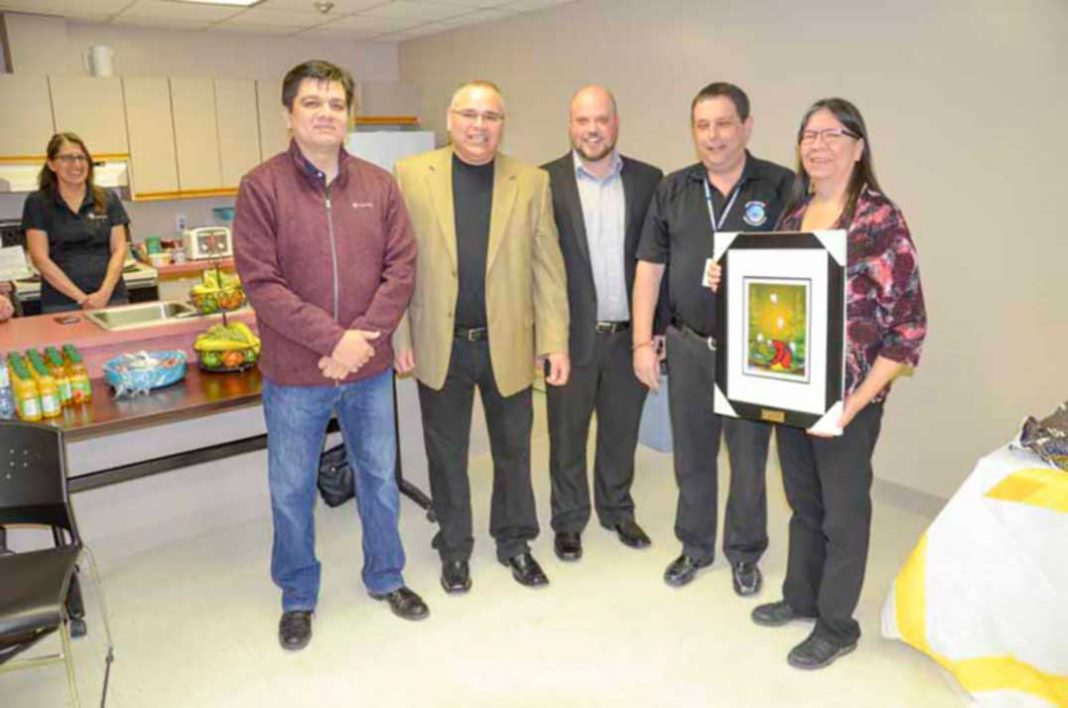WIIKWEMKOONG—Smiles were broad as First Nations health officials and representatives of Telus Health gathered at the Wiikwemkoong Health Centre for the launch of a electronic health records program that offers to revolutionize health delivery to residents of Wiikwemkoong and, as the program extends to more First Nations, other communities as well.
Michael McGregor, Giiwednong Health Link digital health program manager, acted as master of ceremonies for the event and introduced local drum group High Eagle Singers who performed a welcoming song.
An opening invocation was given by Wiikwemkoong elder Rita Corbiere.
Mr. McGregor explained that the “Giiwednong Health Link (GHL) is a health and information management collaboration between the Manitoulin Island and North Shore First Nation health organizations. GHL is focused on planning for and implementing electronic medical records (EMR) systems in the GHL member health centres.”
GHL Chair Roger Beaudin noted that “this has been a long time coming, we first started working on this back in 2006 with the initial discussion of having electronic medical records for Manitoulin and then we invited our partners on the North Shore to join us.” Mr. Beaudin went on to acknowledge the board members in attendance.
Wiikwemkoong Chief Duke Peltier thanked the drum, his council, Ms. Corbiere and acknowledged the work of Health Centre Director Mary Jo Wabuno and her team, before going on to say how important the initiative was to the community. “The whole health data system that is necessary is now available at the fingertips,” he noted.
Telus Health representative Dave Rama joked about the terror the team felt when informed that the Go Live launch event was actually going to take place as the system went live for the first time, but expressed confidence that everything would go forward smoothly. A prediction that apparently held true in the actual event.
“We definitely accepted our role as the lead community,” noted Ms. Wabuno during her remarks and thanks, “and we will share our best practices going forward.”
Digital health benefits of EMR systems to all stakeholders will include: direct and tangible value to the health and well-being of First Nations members; improved health outcomes; enable community-based health organizations will deliver health services with state of the art practice tools and health care services will be improved through better health information management.
GHL was incorporated as a Not-for-Profit Corporation in 2015 and corporate membership includes: Atikameksheng Anishnawbek; Batchewana First Nation; Garden River First Nation; Thessalon First Nation; Mississauga First Nation; Serpent River First Nation; Sagamok Anishnawbek; Wikwemikong Unceded Indian Reserve; M’Chigeeng First Nation; Zhiibaahaasing First Nation; Aundeck Omni Kaning; Sheshegwaning First Nation; Sheguiandah First Nation; Whitefish River Nation; Mnaamodzawin; Noojmowin Teg; and Maamwesying Health Organizations.
The GHL head office is based out of the Aundeck Omni Kaning First Nation and two sub-offices are maintained by GHL—one in Sudbury and the other on the Serpent River First Nation.
Funded by Health Canada, GHL has partnered with Telus Health, Canada’s largest technology company and the developer of the Practice Solutions Suite (PSS) to provide an electronic medical record (EMR) solution.
While GHL was celebrating its first EMR implementation Go Live event at Wikwemikong on Tuesday, March 7, it is planning an implementation of the PSS—EMR solution for all 14 First Nation member communities by March 2018, noted Mr. McGregor.
Following gifts presented to the attending dignitaries, High Eagle Singers concluded the proceedings with an honour song.




